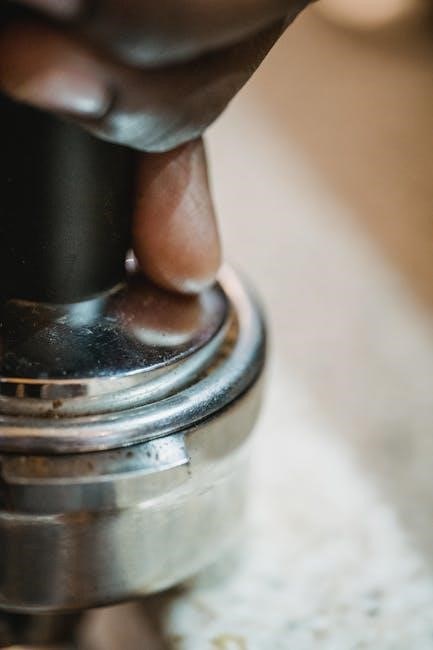and includes important guidelines and instructions for household use only, with specific details on model numbers and supply power ratings always included in the manual content.
Overview of Power Pressure Cooker Models
The power pressure cooker manual provides an overview of different models available, including the Power Pressure Cooker XL PPC772 and PPC790 models, each with its own unique features and specifications.
These models have varying capacities, such as 6-quart and 10-quart, and are designed for household use only.
The manual outlines the key characteristics of each model, including their mode of operation, power ratings, and working pressure.
Understanding the different models and their features is essential for selecting the right power pressure cooker for specific cooking needs.
The power pressure cooker manual serves as a guide for users to navigate the various models and make informed decisions.
By reviewing the manual, users can compare the features and specifications of different models, such as the Power Cooker PC WAL2 and the Power Cooker 6-Quart Pressure Cooker.
This comparison enables users to choose the most suitable model for their cooking requirements.
The overview of power pressure cooker models in the manual is a valuable resource for users, providing them with the necessary information to make the right choice.
With this knowledge, users can confidently select a power pressure cooker that meets their needs and enhances their cooking experience.
The manual’s overview of power pressure cooker models is a crucial component, helping users to understand the different options available and make informed decisions.

Understanding Pressure Cooking Modes
Cooking modes have the same pressure, except canning mode, with default pressure suitable for most meals, and specific timing required for optimal results, as outlined in the power pressure cooker manual and related resources.
Default Pressure and Canning Mode
The default pressure setting on the power pressure cooker is suitable for most cooking tasks, with a pressure difference between high and low settings being around 10 minutes for every hour of cooking time. The canning mode, however, requires a higher pressure, typically around 11 to 12psi, and is used for preserving foods. It is essential to note that the USDA has specific guidelines for safe canning practices, and the power pressure cooker manual provides recipes and instructions for canning using the power pressure cooker. The manual emphasizes the importance of following these guidelines to ensure safe and proper canning. The power pressure cooker’s canning mode is designed to provide the necessary pressure and temperature for killing bacteria and other microorganisms that can cause spoilage. By following the guidelines and recipes provided in the manual, users can safely and effectively can a variety of foods using the power pressure cooker. The default pressure setting and canning mode are two important features of the power pressure cooker that make it a versatile and useful kitchen appliance. The power pressure cooker manual provides detailed information on how to use these features to achieve the best results.

Safety Precautions and Guidelines
Follow safety guidelines and precautions to avoid accidents, read the manual before use, and ensure proper installation and maintenance of the power pressure cooker for safe and efficient operation always and every time.
USDA Safe Canning Rules and Methods
The United States Department of Agriculture (USDA) provides safe canning rules and methods for preserving food, which is essential for users of power pressure cookers who want to can goods. According to the USDA, there is no combination electric pressure cooker approved for canning, and users must follow specific guidelines to ensure safe and proper canning. The USDA recommends using tested recipes and following safe canning procedures to avoid improperly canned goods, which can be hazardous to consume. Power pressure cooker users who want to can goods must use the recipes provided by the manufacturer and follow the USDA’s safe canning rules and methods. The USDA’s guidelines for safe canning include using the right equipment, following tested recipes, and ensuring that the food is heated to the proper temperature to kill off bacteria and other microorganisms. By following the USDA’s safe canning rules and methods, power pressure cooker users can ensure that their canned goods are safe to eat and will retain their nutritional value. Users can find more information on safe canning rules and methods on the USDA’s website or in the power pressure cooker manual.

Manuals and Resources for Power Pressure Cooker
Availability of Owners Manuals

Specific Model Information
Power Pressure Cooker XL models include PPC772 and PPC790, with specific details on each model’s features and specifications, including capacity and power ratings, found in the owner’s manual or on manufacturer’s websites, for user reference always.
Power Pressure Cooker XL PPC772 and PPC790 Models
The Power Pressure Cooker XL PPC772 and PPC790 models are popular electric pressure cookers that come with various features and specifications. The PPC772 model has an 8-quart capacity, while the PPC790 model has a 10-quart capacity, making them ideal for cooking large meals. According to the manual, these models have a rated power of 1000W and a working pressure of 0-70 kPa. The safety working pressure is 80-90 kPa, ensuring safe and efficient cooking. The manual also provides guidelines for household use only, emphasizing the importance of reading the manual thoroughly before using the cooker. The Power Pressure Cooker XL PPC772 and PPC790 models are designed for easy use, with a user-friendly interface and multiple cooking modes. The manual includes detailed instructions on how to use these modes, as well as recipes and cooking tips. Overall, the Power Pressure Cooker XL PPC772 and PPC790 models are reliable and efficient electric pressure cookers that can help users cook a variety of delicious meals. The manual is available online, and users can also find additional resources and recipes on the manufacturer’s website.
